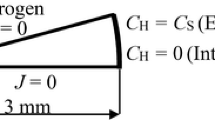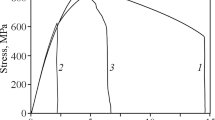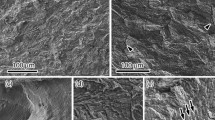Abstract
The effect of hydrogen on the fracture toughness behavior of a nickel-base superalloy, Alloy X-750, in the solutionized and aged condition was investigated. Notched bend specimens were tested to determine if the fracture process was stress or strain controlled. The fracture was observed to initiate at a distance between the location of maximum stress and maximum strain, suggesting that fracture required both a critical stress and strain. The effect of hydrogen was further investigated and modeled using fracture toughness testing and fractographic examination. The fracture toughness of the non-charged specimen was 147 MPa√m. Charging with hydrogen decreased the fracture toughness, K Ic , to 52 MPa√m at a rapid loading rate and further decreased the toughness to 42 MPa√m for a slow loading rate. This is consistent with the rate-limiting step for the embrittlement process being hydrogen diffusion. The fracture morphology for the hydrogen-charged specimens was intergranular ductile dimple, while the fracture morphology of noncharged specimens was a mixture of large transgranular dimples and fine intergranular dimples. The intergranular failure mechanism in Alloy X-750 was a microvoid initiation process at grain boundary carbides followed by void growth and coalescence. One role of hydrogen was to reduce the void initiation strain for the fine intergranular carbides. Hydrogen may have also increased the rate of void growth. The conditions ahead of a crack satisfy the critical stress criterion at a much lower applied stress intensity factor than for the critical fracture strain criterion. A model based on a critical fracture strain criterion is shown to predict the fracture behavior.
Similar content being viewed by others
References
P. Berge: Proc. 1986 Workshop on Advanced High Strength Materials, EPRI, Palo Alto, CA, 1986, NP-6363.
R. Carnahan and G.M. Gordon: Proc. 1986 Workshop on Advanced High Strength Materials, EPRI, Palo Alto, CA, 1986, NP-6363.
C. Benhamou and P. Poitrenaud: Proc. 1986 Workshop on Advanced High Strength Materials, EPRI, Palo Alto, CA, 1986, NP-6363.
C.A. Grove and L.D. Petzold: Corrosion of Nickel-Base Alloys, ASM, Mars, PA, 1985, pp. 165–80.
D.L. Baty, G.O. Hayner, and G.S. Clevinger: Int. Symp. Environmental Degradation of Materials in Nuclear Power Systems—Water Reactors, Palo Alto, CA, 1986.
C.K. Elliott: Ph.D. Thesis, Massachusetts Institute of Technology, Cambridge, MA, 1985.
D.M. Symons and A.W. Thompson: Metall. Mater. Trans. A, 1996, vol. 27A, pp. 101–10.
R.O. Ritchie, W.L. Server, and R.A. Wullaert: Metall. Trans. A, 1979, vol. 10A, pp. 1557–70.
R.O. Ritchie and A.W. Thompson: Metall. Trans. A, 1985, vol. 16A, pp. 233–48.
J. Crank: Mathematics of Diffusion, Claredon Press, Oxford, United Kingdom, 1956.
D.M. Symons: Ph.D. Dissertation, Carnegie Mellon University, Pittsburgh, PA, 1994.
A.W. Thompson: Mater. Sci. Technol., 1990, vol. 1, pp. 711–18.
J.J. Lewandowski and A.W. Thompson: Metall. Trans. A, 1986, vol. 17A, pp. 1769–86.
I. Park and A.W. Thompson: Metall. Trans. A, 1991, vol. 22A, pp. 1615–26.
W. Chu and A.W. Thompson: Metall. Trans. A, 1992, vol. 23A, pp. 1299–1312.
J.C. Chesnutt and R.A. Spurling: Metall. Trans. A, 1977, vol. 8A, pp. 216–18.
J.R. Griffiths and D.R. Owen: J. Mech. Phys. Solids, 1971, vol. 19, pp. 419–31.
J. Gurland and J. Plateau: Trans. ASM, 1963, vol. 56, pp. 442–54.
M. Ashby: Phil. Mag., 1966, vol. 14, pp. 1157–78.
D.M. Symons: Ph.D. Dissertation, Carnegie Mellon University, Pittsburgh, PA, 1994.
A.R. Rosenfield: Metall. Rev., 1968, vol. 13, pp. 29–40.
A.S. Argon, J. Im, and R. Safoglu: Metall. Trans. A, 1975, vol. 6A, pp. 825–37.
A.S. Argon and J. Im: Metall. Trans. A, 1975, vol. 6A, pp. 839–51.
S.H. Goods and L.M. Brown: Acta Metall., 1979, vol. 27, pp. 1–15.
J.W. Hutchinson: J. Mech. Phys. Solids, 1968, vol. 16, pp. 13–31.
J.R. Rice and G.R. Rosengren: J. Mech. Phys. Solids, 1968, vol. 16, pp. 1–12.
J.R. Rice and M.A. Johnson: in Inelastic Behavior of Solids, M.F. Kannimen, ed., McGraw-Hill, New York, NY, 1970, pp. 641–71.
K. Yoshino and C.J. McMahon: in Metall. Trans., 1974, pp 363–70.
Author information
Authors and Affiliations
Rights and permissions
About this article
Cite this article
Symons, D.M., Thompson, A.W. The effect of hydrogen on the fracture toughness of alloy X-750. Metall Mater Trans A 28, 817–823 (1997). https://doi.org/10.1007/s11661-997-0068-8
Received:
Issue Date:
DOI: https://doi.org/10.1007/s11661-997-0068-8




